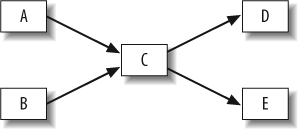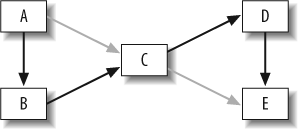Nonlinear pipelines
The pipeline template supports only linear pipelines. It does not directly handle more baroque plumbing, such as in Figure 4-2.

Figure 4-2. Nonlinear pipeline
However, you can still use pipeline for this. One solution is to topologically sort the stages into a linear order, as in Figure 4-3. Another solution, which injects dummy stages to get lower latency, is provided in Chapter 11 in the section titled “Two Mouths: Feeding Two from the Same Task in a Pipeline.”

Figure 4-3. Topologically sorted pipeline
In the topological sorting of the stages (Figure 4-3), the light gray arrows are the original arrows that are now implied by transitive closure of the other arrows. It might seem that a lot of parallelism is lost by forcing a linear order on the stages, but in fact, the only loss is in the latency of the pipeline, not the throughput. The latency is the time it takes a token to flow from the beginning to the end of the pipeline. Given a sufficient number of processors, the latency of the original nonlinear pipeline is three stages. This is because stages A and B could process the token concurrently, and likewise, stages D and E could process the token concurrently. In the linear pipeline, the latency is five stages. The behavior of stages A, B, D, and E may need to be ...
Get Intel Threading Building Blocks now with the O’Reilly learning platform.
O’Reilly members experience books, live events, courses curated by job role, and more from O’Reilly and nearly 200 top publishers.

